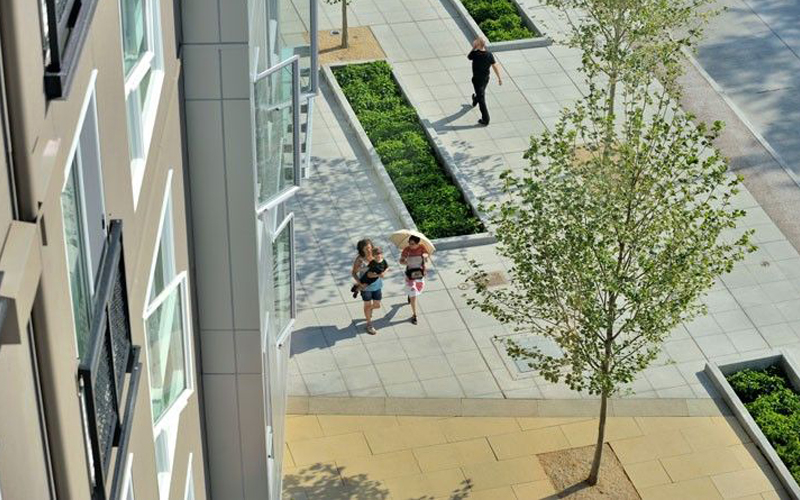Professional Practice
Using Low-Impact Materials: Reflective Materials
 Over 7,500 square feet of asphalt was replaced by landscape areas and high albedo paving, reducing the urban heat island effect. Taylor 28, Seattle, Washington / Mithun.
Over 7,500 square feet of asphalt was replaced by landscape areas and high albedo paving, reducing the urban heat island effect. Taylor 28, Seattle, Washington / Mithun. Solar Reflectance has a significant impact on surface air temperatures in the built environment. Materials with low solar reflectance absorb a larger amount of solar energy, which leads to higher air temperatures and increased energy use. In cities, this contributes to the urban heat island effect. Using reflective, "cool," or white materials helps reduce air temperatures and energy costs by minimizing the use of air conditioning to cool buildings.
Reflective materials offer high solar reflectance – they have an innate ability to reflect sunlight and reduce solar heat absorption. These materials can stay cool in the sun and also have high thermal emittance – they radiate instead of absorb heat. Roofs with high thermal emittance and solar reflectance can stay up to 50-60°F cooler than roofs with conventional materials.
Reflective materials also last longer than conventional materials, which absorb heat and break down faster.
Roofs and pavement can account for 60 percent of ground surfaces in many urban areas. The Environmental Protection Agency (EPA) has actively promoted the use of reflective roofs and roadways as a cheap and effective way to reduce greenhouse gas (GHG) emissions. Chicago has issued a reflective roof ordinance, and California has announced reflective roof rules for government-financed buildings. Reflective pavements should also be considered.
Sources: Using Cool Roofs to Reduce Heat Islands, Environmental Protection Agency; “Global Cooling: Increasing world-wide urban albedos to offset CO2," Hashem Akbari, Surabi, Arthur Rosenfeld, Springer Science + Business Media B.V., 2008
Organizations
Cool Roof Rating Council
Global Cool Cities
European Cool Roofs Council
White Roof Project
Cool California
Heat Island Group
Los Angeles Urban Cooling Collaborative
Resources
A Practical Guide to Cool Roofs and Cool Pavements, Global Cool Cities Alliance
Cooling Cities by Painting Roofs and Roads White, The Dirt, American Society of Landscape Architects
Cool Roofs, U.S. Environmental Protection Agency
Energy Efficient / Cool Roof Resources, EPDM Roofing Association
Interview with Sadhu Johnston, Chief Environment Officer, City of Chicago, American Society of Landscape Architects
U.S. Energy Secretary Steven Chu: Paint Roofs and Surfaces White, The Dirt, American Society of Landscape Architects
Sticks, Stones, Fabric: The Evolution of Sustainable Building Materials, Smart Cities Dive
Cool Pavements, Lawrence Berkeley National Laboratory
Cool Pavements: The Essential Guide, Landscape Architecture Network
War Over Pavements Heats Up, Landscape Architecture Magazine
Case Study: Natural Stone Solar Reflectance Index and the Urban Heat Island Effect, University of Tennessee Center for Clean Products, 2009
Research
“Global Cooling: Increasing world-wide urban albedos to offset CO2," Hashem Akbari, Surabi, Arthur Rosenfeld, Springer Science + Business Media B.V., 2008
“Examples of Cooler Reflective Streets for Urban Heat-Island Mitigation,” Pomerantz, M., Akbari, H., Chang, S., Levinson, R., Pon, B., Lawrence Berkeley National Laboratory
Government Resources
NYC CoolRoofs, City of New York
Cool Roof Regulations, California Energy Commission
Reflective Roof Products, Energy Star
Cool Roofs, Department of Energy
Projects
Taylor 28, Seattle, Washington
Mithun
Park Seventeen Roof Garden, Dallas, Texas
TBG Partners